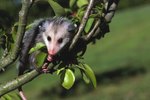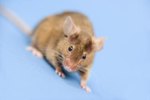
According to National Geographic, more than 60 opossum species inhabit the United States, Mexico and Canada. Although 'possums appear to be large rodents, they are actually marsupials. Opossums are omnivores that live in habitats such as woodlands, farmlands and even residential areas. Differences between male and female opossums abound.
Appearance
Male possums are noticeably larger than females, weighing up to 15 pounds and measuring around 28 inches long from head to tail. Females typically weigh no more than eight pounds. In addition to size differences, you can tell a male apart from a female by the color of the male's chest hair. Males have a skin gland used for chemical communication that stains the chest fur yellow. Females have a fur-lined pouch for raising and carrying infants.
Behavior
Although opossums are generally solitary and shy, males can become quite territorial during mating season. Out of mating season, males remain territorial and will fight other males that are nearby. Females are known to be aggressive, although they get along with other females if needed. For example, females sometimes live in small groups of other female opossums in addition to their own offspring, especially during the winter to stay warm.
Reproduction
Male 'possums have bifurcated, or branched, penes. Females have internal bifurcated reproductive tracts. When ready to mate, males emit a clicking noise to attract females. After giving birth to embryo-size offspring, a female opossum carries her young in her pouch as they continue to develop. Females give birth to one to three litters each year. Each litter typically has an average of eight or nine infants, although more than 20 infants can be in a single litter.
Life Span Factors
Opossums generally live between two to three years, according to the Wildlife Rescue League. Reproduction is risky business for opossums. Males wandering in search of females to mate with often become injured or killed on busy roads or falling prey to larger animals like dogs. Females traveling with babies attached are slower and can not run as fast to get away from predators or traffic. Fewer than half of each litter survives, since there are generally not enough functional nipples for each infant to attach to after birth.
References
Resources
Photo Credits
-
Hemera Technologies/Photos.com/Getty Images
Writer Bio
Amanda Williams has been writing since 2009 on various writing websites and blogging since 2003. She enjoys writing about health, medicine, education and home and garden topics. Williams earned a Bachelor of Science in biology at East Stroudsburg University in May 2013. Williams is also a certified emergency medical technician.




